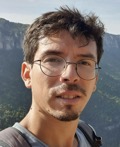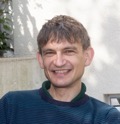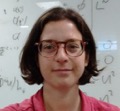Program
Outreach
As part of the popularization of science, a musical conference was given at the Spaziu Culturale (in French).
3 histoires de Gravité

Ugo Moschella, Universita dell'Insubria, Como, Italy
La science en tant que facteur de la vie humaine est un retardataire. L’art existait avant la dernière époque glaciaire et a au moins cinquante mille ans. La science moderne, au contraire, est née il y a seulement quatre cents ans : Galilée était le père et la gravité l’accoucheuse ; l’historiographie et la tradition ont assigné le rôle d’événement mythique fondateur au récit de l’Expérience de Galilée à la tour penchée de Pise. Deux autres contes, Newton assis sous le pommier et la pensée la plus heureuse d’Einstein de sa vie, articulent l’histoire des idées que nous avons sur la gravité.
Lectures
In order to attend the school, some minimal knowledge are required in Cosmology, in Statistics and Probability.
Cosmology from Weak Lensing

Alexandra Amon, Kavli Institute for Cosmology, Cambridge
Weak lensing is a powerful probe of the late-time Universe and the large-scale structure. Measurements constrain the amount of matter in the Universe and the amplitude of clustering, with the combination of the two known as S8. Weak galaxy lensing surveys have consistently reported a lower amplitude for the matter fluctuation spectrum, as measured by the S8 parameter, than expected in the ΛCDM cosmology favoured by Planck. I will review how weak lensing analyses are carried out, from pixels to cosmological parameters, including the challenges faced and the state-of-the-art methods to overcome them. I will discuss the current status of tensions and possible resolutions.
- Lecture 1
- Chapter 1 – Weak lensing in practice
- Chapter 2 – Current and future photometric surveys: From DES/HSC/KiDS to Rubin/Euclid/Roman
- Chapter 3 – The S8 tension
- Lecture 2
- Chapter 1 – From pixels to shear measurements: challenges from data
- Chapter 2 – From measurements to cosmology: challenges from galaxy formation
- Chapter 3 – Looking ahead and synergies with other surveys
Literature
- "Weak lensing for precision cosmology" - Rachel Mandelbaum arxiv.org/abs/1710.03235
- "Weak gravitational lensing" - Matthias Bartelmann, Matteo Maturi aarxiv.org/abs/1612.06535
- "A non-linear solution to the S8 tension?" - Alexandra Amon, George Efstathiou arxiv.org/abs/2206.11794
Prerequisites
The course will mostly be self-contained.
Cosmological Simulations

Raúl Angulo, Ikerbasque, Donostia International Physics Centre
In this course, I will give an overview of the field of cosmological simulations of the large-scale structure of the Universe. I will summarize the main numerical algorithms employed, the techniques to generate initial conditions, and the various possible alternatives for describing dark matter. I will also discuss several issues to achieve robust and accurate results. I will finalize by describing the connection to cosmological observables and by providing an outlook for the next decade.
- Chapter 1 – Numerical Algorithms: Discretization, Force Calculations, and Time Evolution
- Chapter 2 – Initial Conditions
- Chapter 3 – Modelling dark matter
- Chapter 4 – High-accuracy simulations
- Chapter 5 – Connection to observables
Literature
- "Large-scale dark matter simulations", Raúl E. Angulo, Olivier Hahn - Living Reviews in Computational Astrophysics - link.springer.com/article/10.1007/s41115-021-00013-z
Prerequisites
A basic introductory course in cosmology.
Cosmology with Spectroscopic Surveys

Julian Bautista, Centre de Physique des Particules de Marseille.
In the past twenty years, spectroscopic surveys have become one of the more powerful methods to map the three-dimensional matter distribution in our Universe. From these maps, we can learn about dark energy, inflation, neutrino masses and possible alternatives to general relativity. In these lectures, I will overview the process of collecting photons all the way to obtaining cosmological constraints, both for the case of galaxies as well as for the special case of Lyman-alpha forests. Most of these lectures are based on the case of the Sloan Digital Sky Survey, but most of these concepts apply for future spectroscopic surveys.
- Lecture 1
- Chapter 1 – Why do we need spectroscopic surveys ?
- Chapter 2 – From photons to spectra
- Chapter 3 – From spectra to clustering : case of galaxies
- Lecture 2
- Chapter 1 – From spectra to clustering : case of Lyman-alpha forests
- Chapter 2 – Latest cosmological constraints from SDSS
Literature
- "The SDSS-IV Extended Baryon Oscillation Spectroscopic Survey: Overview and Early Data" (eBOSS overview), Dawson et al., The Astronomical Journal, 151:44,2016 - arxiv.org/abs/1508.044735
- "Completed SDSS-IV extended Baryon Oscillation Spectroscopic Survey: Cosmological implications from two decades of spectroscopic surveys at the Apache Point Observatory" (SDSS cosmological implications), Shadab Alam et al. Phys. Rev. D 103, 083533 (2021) - arxiv.org/abs/2007.08991
Prerequisites
PhD level and above. Basics of cosmology and perturbation theory
Multimessenger Astronomy and its Connection with Cosmology

Frédéric Daigne, Sorbonne University - Institut d’Astrophysique de Paris (IAP).
This course will be devoted to the constraints that high-energy and multi-messenger astrophysics can bring to cosmology. We will start by outlining the instrumental and observational landscape in this field. We will then discuss more specifically the applications to cosmology, insisting on the contributions of the multi-messenger approach and particularly the results obtained by crossing gravitational and electromagnetic observations of the 170817 neutron star merger. We will conclude this course by discussing several promising perspectives.
- Lecture 1 – Introduction: high-energy/multimessenger astronomy, its connection with cosmology.
- Lecture 2 – The contribution of multi-messenger astronomy to cosmology: first results and perspectives.
Literature
- "Advancing the Landscape of Multimessenger Science in the Next Decade", contribution to Snowmass 2021 (US Community Study on the Future of Particle Physics)
- "A gravitational-wave standard siren measurement of the Hubble constant", Abbott et al., Nature, volume 551, issue 7678, pp. 85-88 (2017), - https://arxiv.org/abs/1710.05835
- "A Hubble constant measurement from superluminal motion of the jet in GW170817", Hotokezaka et al., Nature Astronomy, volume 3n pp. 940-944 (2019) - arxiv.org/abs/1806.10596
- "The potential role of binary neutron star merger afterglows in multimessenger cosmology", Mastrogiovanni et al., A&A, volume 652, id.A1 (2021). - arxiv.org/abs/2012.12836
Prerequisites
The course will mostly be self-contained.
The SPHEREx All-Sky Spectroscopic Survey

Olivier Doré , California Institute of Technology, United State of America.
SPHEREx is a NASA Astrophysics medium Explorer mission to produce a near-infrared all-sky spectrophotometric survey. The 2-year mission will result in a spectrum for every 6-arcsecond pixel on the sky between 0.75 and 5 microns at spectral resolution varying between R=35 and 130. The mission is optimized to address three science themes :
- 1. inflation in the early Universe through searching for imprints of non-Gaussianity on the large scale structure in the universe;
- 2. the history of galaxy formation through measuring spectra of the extragalactic background fluctuations;
- 3. the inventory of biogenic ices in our own Galaxy by surveying ice absorption features towards stars..
Useful Links
- "SPHEREx", - An All-Sky Spectral Survey
Literature
- "Cosmology with the SPHEREX All-Sky Spectral Survey", Olivier Doré, et al., - arxiv.org/abs/1412.4872
- "Science Impacts of the SPHEREx All-Sky Optical to Near-Infrared Spectral Survey: Report of a Community Workshop Examining Extragalactic, Galactic, Stellar and Planetary Science", Olivier Doré, et al., - arxiv.org/abs/1606.07039
- "Science Impacts of the SPHEREx All-Sky Optical to Near-Infrared Spectral Survey II: Report of a Community Workshop on the Scientific Synergies Between the SPHEREx Survey and Other Astronomy Observatories", Olivier Doré, et al. - arxiv.org/abs/1805.05489
Prerequisites
The course will mostly be self-contained.
Cosmic Microwave Background and Hubble Parameter Measurements

Antony Lewis, University of Sussex.
Cosmic microwave background observations give very powerful constraints on cosmological models. They contain temperature and polarization information about the perturbations in the early-universe, and can also be used to extract information about gravitational lensing and large-scale structure. I will discuss the basic physics, what can be observed and current/planned observations, and what can be learnt from these CMB observations. Inferences about late-time cosmological parameters like the Hubble parameter are model dependent, but seem to be in conflict with some recent local measurements if the standard ΛCDM model is correct. I will review how the Hubble parameter is measured from local measurements and the CMB, and discuss the current status of tensions and possible resolutions.
- Lecture 1 – Cosmic microwave background.
- Lecture 2 – Hubble parameter from CMB, local measurements and other data.
Literature
- "Lecture notes on the physics of cosmic microwave background anisotropies”, Anthony Challinor, Hiranya Peiris. -arxiv.org/abs/0903.5158 .
- "Weak Gravitational Lensing of the CMB", Antony Lewis, Anthony Challinor - arxiv.org/abs/astro-ph/0601594/a>.
Useful books
- "Cosmology", Daniel Baumann, arXiv:astro-ph/0504022.
Prerequisites
I will assume basic familiarity with background cosmological models, relativity etc.
Fundamental cosmology from the galaxy distribution

John Peacock, University of Edinburgh.
The large-scale distribution of galaxies was the first means of studying cosmological metric perturbations, and continues to provide unique information on aspects of the cosmological model and the assembly of structure. The field is poised for a major advance, as the DESI and Euclid projects will together provide redshift catalogues perhaps 30 times larger than those presently available. These lectures will give an overview of the main science goals for these surveys, summarizing the main statistical tools and the theory used to relate galaxies to the distribution of dark matter. Emphasis will be given to the role of large-scale structure in providing complementary information to that from the Cosmic Microwave background and other probes, breaking degeneracies and giving an independent view of cosmological ‘tensions’ – inconsistencies between different estimates of key cosmological parameters.
- Lecture 1 – Galaxies and density fluctuations.
- Linear growth and transfer functions
- The acoustic horizon and BAO
- Redshift-space distortions
- Dark-matter haloes and biased clustering
- Impact of non-Gaussianity
- Lecture 2 – Key applications of large-scale structure.
- The inverse distance ladder
- Fluctuation growth and modified gravity
- Detecting massive neutrinos
- Impact of LSS on the CMB: lensing, ISW, SZ
- Implications for Hubble and normalisation tensions
Background reading
- "Advanced cosmology lecture notes" :https://www.roe.ac.uk/japwww/teaching/cos5_1213/cos5_full.pdf.
- "Halo model and CMB foregrounds": arxiv.org/pdf/astro-ph/0206508.
Cosmology with Neutral Hydrogen Intensity Mapping

Alkistis Pourtsidou, University of Edinburgh.
Traditionally, large-scale structure surveys aim to detect individual galaxies in three dimensions. This involves measuring the redshift of each galaxy as well as its angular position on the sky, and then creating a catalog and a corresponding 3D map. This procedure has been routinely used by optical galaxy surveys like SDSS and has led to constraints on dark energy, gravity, and the initial conditions of the Universe. An alternative proposal is to map the large-scale structure of the Universe using the redshifted 21cm line from the spin flip transition in neutral hydrogen (HI) with radio telescopes. The HI Intensity Mapping technique does not require the often difficult and expensive detection of individual galaxies. Instead, it maps the entire Hi flux coming from many galaxies together in large 3D pixels, across the sky and along time. In my lectures I will introduce the HI Intensity Mapping technique and its applications to cosmology and galaxy evolution studies. I will present MeerKAT and the SKA, and their synergies with optical galaxy surveys like Euclid. I will also introduce a couple of useful open-source codes and provide pedagogical Jupyter notebooks for further study.
- Chapter 1 – Introduction to the HI Intensity Mapping technique.
- Chapter 2 – Applications to galaxy evolution and cosmology.
- Chapter 3 – Presentation of MeerKAT and the SKA, and synergies with Euclid.
- Chapter 4 – Open-source numerical tools.
Literature
- "Unveiling the Universe with Emerging Cosmological Probes" (Section 3.8), Moresco et al. arxiv.org/abs/2201.07241 .
- "Baryon Acoustic Oscillation Intensity Mapping as a Test of Dark Energy", Chang et al - arxiv.org/abs/0709.3672.
- "Measurement of 21 cm brightness fluctuations at z ∼ 0.8 in cross-correlation", Masui et al. - arxiv.org/abs/1208.0331.
Prerequisites
Some knowledge of cosmology from large-scale structure will be helpful.
Galaxy Clustering: Observables & Theoretical Modelling

Emiliano Sefusatti, INAF Osservatorio Astronomico di Trieste.
I will introduce the main observables in spectroscopic redshift surveys: the 2-point correlation function and its Fourier-space counterpart, the power spectrum. I will provide an overview of their theoretical modelling in Eulerian perturbation theory highlighting how information on the cosmological model can be extracted from their most relevant features. I will mention how and what additional information could be provided by the analysis of higher-order correlation functions.
- Lecture 1
- Chapter 1 – The galaxy distribution as a random field
- Chapter 2 – Galaxy clustering observables: power spectrum & 2-point correlations function
- Chapter 3 – Linear Eulerian Perturbation Theory (PT)
- Chapter 4 – Nonlinear PT and the power spectrum at one-loop, EFTofLSS
- Chapter 5 – Non-Gaussianity and Higher-order correlation functions
- Lecture 2
- Chapter 1 – Baryonic Acoustic Oscillations & Infrared Resummation
- Chapter 2 – Galaxy bias & redshift-space distortions
- Chapter 3 – Estimators & statistical errors
- Chapter 4 – Recent analyses of the BOSS survey
Literature
- "Large-scale structure of the Universe and cosmological perturbation theory", Bernardeau at al., Phys. Rep. 367 (2002) 1–248. arXiv:astro-ph/0112551 .
- "Large-scale galaxy bias", Desjacques at al., Phys. Rep. 733 (2018) 1-193 doi:10.1086/519947 - arXiv:1611.097874.
Prerequisites
I will assume previous knowledge of basic elements of homogeneous cosmology: cosmological redshift, FRW metric, Friedmann equations. I will introduce the main features of the linear matter power spectrum at recombination but, due to the time limit, without providing a proper explanation of its origins from inflation and subsequent linear evolution, including baryonic acoustic oscillations.
Statistical Cosmology

Benjamin D. Wandelt, IAP Sorbonne University.
Statistical Cosmology is the subject that studies how we can extract cosmological information by confronting cosmological models with data. Recent breakthroughs in Machine Learning have opened up a vast new playing field where we find the solutions to many problems that were previously thought to be intractable. I will explain the powerful principles that underlie the current transformation of Statistical Cosmology and sketch the new approach to physical cosmology that they enable. My focus will be on the central problems of modern cosmology: the cosmic beginning and the dark universe. As these new powers propel us forward, new challenges come into view. What will be the ultimate limit to cosmological knowledge? How do we deal with imperfections in our physical models when every detail can be tested against data?
- Lecture 1 : Elements
- Chapter 1 – Elements of Bayesian Statistics
- Chapter 2 – Elements of Cosmological Information
- Chapter 3 – Implicit vs Explicit Inference
- Chapter 4 – Elements of Neural Computation
- Chapter 5 – Optimization and Monte Carlo
- Lecture 2 : Applications
- Chapter 1 – How to Solve Cosmological Inference
- Chapter 2 – The Simulation Bottleneck and Generative Modelling
- Chapter 3 – The Dangers of Nearly Limitless Power
- Chapter 4 – Challenges of Cosmology as an Observational Science
Optional reading
Students wishing to read a gentle introduction to statistical cosmology without machine learning may read chapters 1 to 3 of "Cosmology: from theory to data, from data to theory". arxiv.org/abs/1403.1260. The following papers go into more depth. They develop several of the machine learning topics I will touch on in the lectures:
- "Generalized massive optimal data compression". arxiv.org/abs/1712.00012.
- "Solving high-dimensional parameter inference: marginal posterior densities & Moment Networks". - arxiv.org/abs/2011.05991.
- "Fast likelihood-free cosmology with neural density estimators and active learning". - .
- "Automatic physical inference with information maximising neural networks". - arxiv.org/abs/1903.00007.
- "Lossless, Scalable Implicit Likelihood Inference for Cosmological Fields". - arxiv.org/abs/2107.07405. This paper comes with a Google Colab notebook that provides a detailed guide to reproducing the analysis in the paper.
- "The Cosmic Graph: Optimal Information Extraction from Large-Scale Structure using Catalogues". - arxiv.org/abs/2207.05202.
Prerequisites
The lectures will be largely self-contained.
Short talks and Posters
Seminars complete the program and the PhD students, as part of their training, were invited to submit a short lecture or a poster. These were exhibited throughout the week and served as support for the discussions.